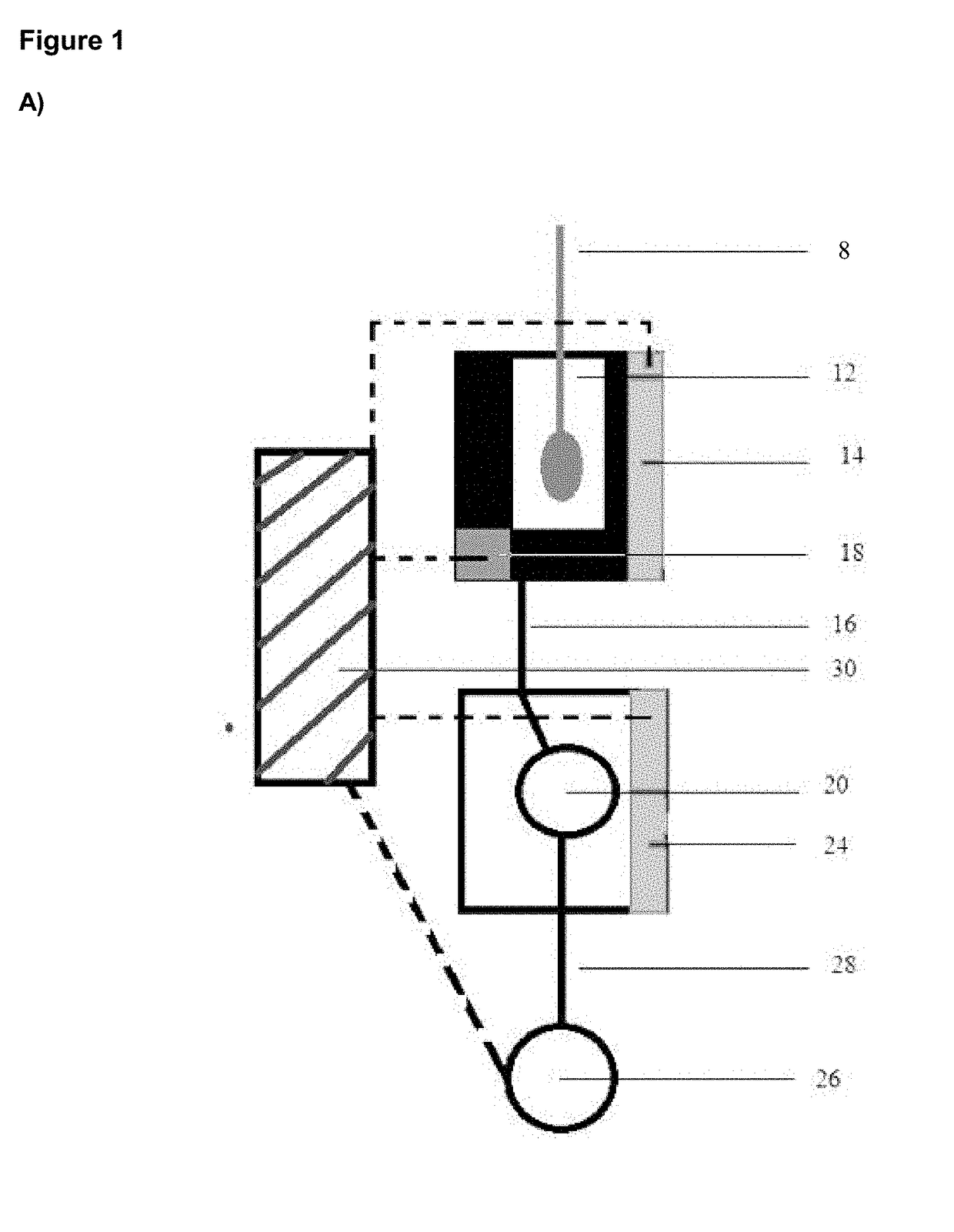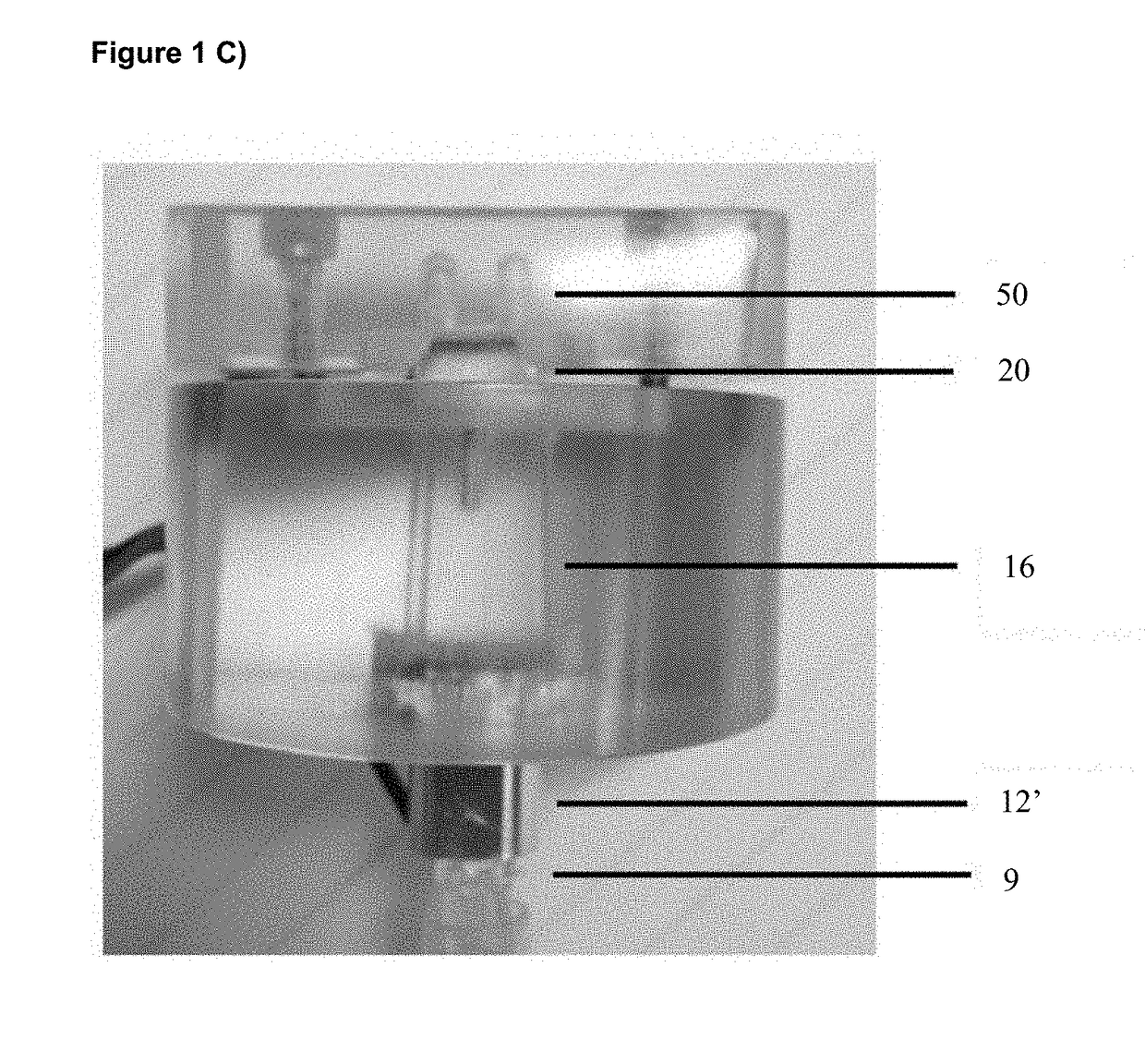Fully integrated hand-held device to detect specific nucleic acid sequences
- Summary
- Abstract
- Description
- Claims
- Application Information
AI Technical Summary
Benefits of technology
Problems solved by technology
Method used
Image
Examples
example 1
ice for Pathogen Detection
Device Design
[0105]A hand-held, disposable device 10 is provided (FIG. 1B). The device 10 comprises a first extraction chamber 12 having a maximum volume of about 250 μl. The extraction chamber 12 includes a lysing reagent of PBS with 0.1% Triton X-100. The extraction chamber 12 includes an opening 11 for accepting the head of a sample-containing swab and the chamber 12 is sized to accept the swab. A lid 13 is provided to seal opening 11 of the extraction chamber 12. Closing of lid 13 activates the device 10 by causing release of buffer into the extraction chamber 12 from a blister pack. The extraction chamber 12 is fitted with a first self-regulating heater 14, activated on closing lid 13, that heats the extraction chamber 12 to a temperature of about 95° C. and maintains this temperature for at least 2 minutes, e.g. by the use of a timer. The heater 14 is connected to control unit 30 and powered by battery 34.
[0106]The extraction chamber 12 is connected b...
example 2
[0120]Clinical Analysis
[0121]The device 10 was tested using clinical Influenza-positive nasopharyngeal swabs, RSV-positive nasopharyngeal swabs, and S. pyogenes-positive throat swabs. Swabs were obtained from infected patients that were known to be positive based on culturing methods. The swabs were then inserted into the extraction chamber 12 of the device 10. The extraction chamber was filled with 250 μl of PBS and heated at 93° C. for 3 minutes. Subsequently, the lysed material was pumped into the amplification chamber 22, where it was mixed with LAMP master mix. The amplification chamber 22 was then activated for 15 minutes (heated to 63° C.) and DNA was detected visually after mixing with Quant-It PicoGreen DNA binding dye in the viewing windows (vials in FIG. 1c). Pathogens were detected within 20 minutes using the device.
example 3
[0122]An example embodiment of the hand-held, disposable device is shown in the photograph of FIG. 1C, incorporating key functional modules and structures described herein. Sample extraction and Lysis were both carried out within extraction / lysing chamber 12′, while DNA amplification and viewing / detection were carried out in the subsequent amplification chambers 20 connected by microfluidic channels 16, and detection chambers 50 for displaying results. In this example, the extraction / lysing chamber 12′ is adapted to accept the swab at swab insertion point 9. This embodiment incorporates one (1) extraction / lysing chamber 12′ constructed with metal alloy material, two parallel amplification chambers 20 constructed with metal alloy material, two parallel microfluidic channels 16 and two detection chambers 50 constructed with polymer material. Therefore, this embodiment device is capable of detecting two different indications from the same sample swab or detecting one indication and one...
PUM
| Property | Measurement | Unit |
|---|---|---|
| Temperature | aaaaa | aaaaa |
| Temperature | aaaaa | aaaaa |
| Temperature | aaaaa | aaaaa |
Abstract
Description
Claims
Application Information
 Login to View More
Login to View More - R&D
- Intellectual Property
- Life Sciences
- Materials
- Tech Scout
- Unparalleled Data Quality
- Higher Quality Content
- 60% Fewer Hallucinations
Browse by: Latest US Patents, China's latest patents, Technical Efficacy Thesaurus, Application Domain, Technology Topic, Popular Technical Reports.
© 2025 PatSnap. All rights reserved.Legal|Privacy policy|Modern Slavery Act Transparency Statement|Sitemap|About US| Contact US: help@patsnap.com



